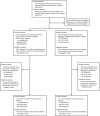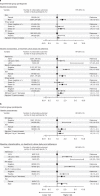A patient-level pooled analysis of treatment-shortening regimens for drug-susceptible pulmonary tuberculosis
- PMID: 30397355
- PMCID: PMC6685538
- DOI: 10.1038/s41591-018-0224-2
A patient-level pooled analysis of treatment-shortening regimens for drug-susceptible pulmonary tuberculosis
Erratum in
-
Publisher Correction: A patient-level pooled analysis of treatment-shortening regimens for drug-susceptible pulmonary tuberculosis.Nat Med. 2019 Jan;25(1):190. doi: 10.1038/s41591-018-0294-1. Nat Med. 2019. PMID: 30429542 Free PMC article.
Abstract
Tuberculosis kills more people than any other infectious disease. Three pivotal trials testing 4-month regimens failed to meet non-inferiority margins; however, approximately four-fifths of participants were cured. Through a pooled analysis of patient-level data with external validation, we identify populations eligible for 4-month treatment, define phenotypes that are hard to treat and evaluate the impact of adherence and dosing strategy on outcomes. In 3,405 participants included in analyses, baseline smear grade of 3+ relative to <2+, HIV seropositivity and adherence of ≤90% were significant risk factors for unfavorable outcome. Four-month regimens were non-inferior in participants with minimal disease defined by <2+ sputum smear grade or non-cavitary disease. A hard-to-treat phenotype, defined by high smear grades and cavitation, may require durations >6 months to cure all. Regimen duration can be selected in order to improve outcomes, providing a stratified medicine approach as an alternative to the 'one-size-fits-all' treatment currently used worldwide.
Conflict of interest statement
The authors declare no competing interests.
Figures




Comment in
-
A stratified approach to tuberculosis treatment.Nat Med. 2018 Nov;24(11):1639-1641. doi: 10.1038/s41591-018-0244-y. Nat Med. 2018. PMID: 30401868 No abstract available.
References
-
- World Health Organization. Guidelines for Treatment of Drug-Susceptible Tuberculosis and Patient Care, 2017 Update (World Health Organization, Geneva, 2017).

